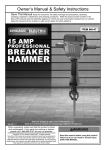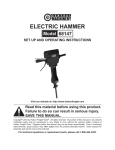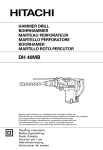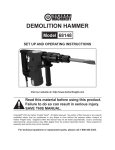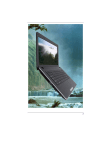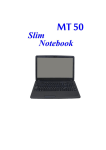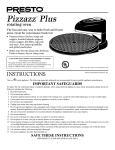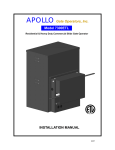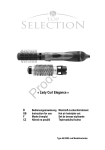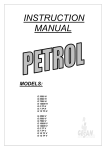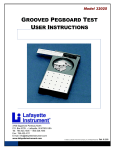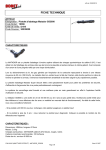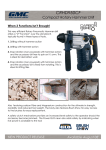Download Hitachi H90SB User's Manual
Transcript
Demolition Hammer Model H 90SB Instruction manual Note: Before using this HITACHI Demolition Hammer, carefully read through this INSTRUCTION MANUAL to ensure efficient, safe operation. It is recommended that this INSTRUCTION MANUAL be kept readily available as an important reference when using this power tool. Double insulation We sincerely thank you for selecting a HITACHI POWER TOOL. To operate this power tool safely and efficiently, please read this INSTRUCTION MANUAL carefully to get a good understanding of the precautions in operation, capacity of the power tool, use and the like. IMPORTANT INFORMATION: SAFETY RULES FOR THE POWER TOOL WARNING: When using the power tool, following basic safety precautions should always be followed to reduce the risk of fire, electric shock, and personal injury. READ ALL INSTRUCTIONS 1. KEEP WORK AREA CLEAN. Cluttered areas and benches invite injuries. 2. CONSIDER WORK AREA ENVIRONMENT. Don’t expose power tools to rain. Don’t use power tools in damp or wet locations. Keep work area well lit. Don’t use the power tool in presence of flammable liquids or gases. Power tools produce sparks during operation. They also spark when switching ON/ OFF. Never use power tools in dangerous sites containing lacquer, paint, benzine, thinner, gasoline, gases, adhesive agents, and other materials which are combustible or explosive. 3. GUARD AGAINST ELECTRIC SHOCK. Prevent body contact with grounded surfaces. For example: pipes, radiators, ranges refrigerator enclosures. 4. KEEP VISITORS OR CHILDREN AWAY. Do not let visitors or children contact the power tool or extension cord. All visitors or children should be kept away from work area. 5. STORE IDLE POWER TOOLS. When not in use, power tools should be stored in dry, and high or locked-up place-out of reach of children. 6. DON’T FORCE THE POWER TOOL. It will do the job better and safer at the rate for which it was intended. 7. USE RIGHT POWER TOOLS. Don’t force a small power tool or attachment to do the job of a heavy-duty tool. Don’t use the power tool for purpose not intended - for example don’t use circular saw for cutting tree limbs or logs. 8. DRESS PROPERLY. Do not wear loose clothes or accessories. They can be caught in moving parts. Rubber gloves and non-skid footwear are recommended when working outdoors. Wear protective hair covering to contain long hair. 9. USE SAFETY GLASSES. All persons in the area where power tools are being operated should also wear safety eye protectors, and face or dust masks if cutting operation is dusty. 10. DON’T ABUSE CORD. Never carry power tools by cord or yank the cord to disconnect the power tool from receptacle. Keep the cord from heat, oil and sharp edges. 11. DON’T OVERREACH. Keep proper footing and balance at all times. 12. MAINTAIN POWER TOOLS WITH CARE. Keep power tools sharp and clean for better and safer performance. Follow instructions for lubricating and changing accessories. Inspect tool cords periodically and if damaged, have repaired by the authorized service center. Inspect extension cords periodically and replace them if damaged. Keep handles dry, clean, and free from oil and grease. 1 13. DISCONNECT POWER TOOLS. When not in use, before servicing, and when changing accessories, such as blades, bits, cutters. 14. REMOVE ADJUSTING KEYS AND WRENCHES. Form habit of checking to see that keys and adjusting wrenches are removed from the power tool before turning it on. 15. AVOID UNINTENTIONAL STARTING. Don’t carry a plugged-in the power tool with finger on switch. Be sure switch is off when plugging in. 16. OUTDOOR USE EXTENSION CORDS. When the power tool is used outdoors, use only extension cords intended for use outdoors and so marked. 17. STAY ALERT. Watch what you are doing. Use common sense. Do not operate the power tool when you are tired. 18. CHECK DAMAGED PARTS. Before use of the power tool, a guard or other part should be carefully checked to determine that it will operate properly and perform its intended function. Check the alignment of moving parts, binding of moving parts, breakage of parts, mounting, and any other conditions that may affect its operation. A guard or other part that is damaged should be properly repaired or replaced by an authorized service center unless otherwise indicated elsewhere in this instruction manual. Have defective switches replaced by an authorized service center. Do not use the power tool if switch does not turn it on and off. 19. AVOID USING A POWER TOOL FOR APPLICATIONS OTHER THAN THOSE SPECIFIED. Never use the power tool for applications other than those specified in this instruction manual. 20. ENSURE SAFE OPERATION THROUGH CORRECT HANDLING. Secure safe operation through correct handling by observing the instructions described herein. Do not employ accessories other than those specified herein; otherwise, a hazardous condition may be created. Never allow the power tool to be used by persons not familiar with correct handling (such as chidren) or by those who are not familiar with the power tool. 21. CONFIRM THAT NO ITEMS SUCH AS AN ELECTRIC CABLE OR CONDUIT ARE BURIED INSIDE. In places where electric wiring may be hidden behind a wall, floor, ceiling, etc. do not hold or contact any metal parts of the poweer tool. In such cases, metal parts could become electrically live and present a serious shock hazard. 22. KEEP THE RIGHT PARTS IN THE RIGHT POSITIONS. Do not remove covers and screws which have been factory-mounted. They perform important respective roles. Keep them in the original positions. 23. SHOULD THE PLASTIC HOUSING OR HANDLE OF THE POWER TOOL BE CRACKED OR DEFORMED, DO NOT USE IT. Since cracked or deformed parts may lead to an operator receiving an electric shock, do not use such a power tool. Immediately have it repaired. 24. SECURELY MOUNT ACCESSORIES AND BLADES TO THE POWER TOOL MAIN BODY. Extra care must be taken when using the power tool on elevated location (such as a roof ladder, scaffold, or the like) to prevent injury to someone underneath in the event the power tool and/or accessory should drop. 25. ALWAYS KEEP THE MOTOR AIR VENT FULLY OPENED. A constantly open motor air vent is necessary to allow air to come in and out for cooling the motor. Do not allow it to become clogged up, even if dust is blown through it. 26. OPERATE THE POWER TOOL AT THE RATED VOLTAGE. Operate the power tool at voltages specified on its nameplate. 27. NEVER TOUCH THE MOVING PARTS. Never touch the moving parts such as blades, bits, cutters and others. 2 28. STOP OPERATION IMMEDIATELY IF ANY ABNORMALITY IS DETECTED. Should the power tool be detected as out of order or should other abnormalities be observed during operation, stop using the power tool immediately. 29. NEVER LEAVE THE POWER TOOL RUNNING UNATTENDED. TURN POWER OFF. Don’t leave the power tool until it comes to a complete stop. 30. CAREFULLY HANDLE THE POWER TOOL. Should the power tool be dropped or struck against hard materials inadvertently, it may be deformed, cracked, or damaged. 31. DO NOT WIPE PLASTIC PARTS WITH SOLVENT. Solvents such as gasoline, thinner, benzine, carbon tetrachloride, and alcohol damage and crack plastic parts. Do not wipe them with such solvents. Wipe plastic parts with a soft cloth lightly dampened with soapy water. 32. WHEN REPLACING A COMPONENT PART, ADOPT THE SAME TYPE. When replacing a component part with a new one, adopt the same type of new part. Also, never attempt to repair the power tool yourself. Bring it to an authorized service center for repair. SERVICE AND REPAIRS All quality tools will eventually require servicing or replacement of parts due to wear from normal use. These operations should ONLY be performed by an AUTHORIZED SERVICE CENTER. REPLACEMENT PARTS When servicing use only identical replacement parts. POLARIZED PLUGS To reduce the risk of electric shock, this equipment has a polarized plug (one blade is wider than the other). This plug will fit in a polarized outlet only one way. If the plug does not fit fully in the outlet, reverse the plug. If it still does not fit, contact a qualified electrician to install the proper outlet. Do not change the plug in any way. EXTENSION CORD Make sure your extension cord is in good condition. When using an extension cord, be sure to use one heavy enough to carry the current the power tool will draw. An undersized cord will cause a drop in line voltage resulting in loss of power and overheating. Table below shows the correct size to use depending on cord length and nameplate ampere rating. If in doubt, use the next heavier gage. The smaller the gage number, the heavier the cord. MINIMUM GAGE FOR CORD SETS Total Length of Cord in Feet (Meter) 0 – 25 (0 – 7.6) Ampere More Than Rating Not More Than 0–6 6 – 10 10 – 12 12 – 16 3 26 – 50 51 – 100 101 – 150 (7.9 – 15.2) (15.5 – 30.5) (30.8 – 45.7) AWG 18 18 16 14 16 16 16 12 16 14 14 12 14 12 Not Recommended DOUBLE INSULATION SYSTEM ENHANCES SAFE OPERATION To enhance safe operation of this power tool, HITACHI has adopted a double insulation system. The term “double insulation” used here denotes an insulation system with two insulations physically separated and arranged between the electrically conductive material connected to the power supply and the outer frame subject to contact by the operator. Thus, the power tool is termed double insulated and both the “ ” mark and “Double insulation”, or either one is indicated on the name plate. DOUBLE INSULATION While no external grounding is required with this system, normal safety precautions as outlined in this manual must still be followed. To maintain the effectiveness of the double insulation system, follow the precautions described below: 1. Always contact your dealer or an authorized service center when assembling, disassembling or replacing parts other than accessories or carbon brushes. Improper assembly and/or replacement with wrong parts may result in eliminating the double insulation-feature. 2. Clean the exterior of the power tool with a soft cloth moistened with soapy water, and dry thoroughly. Chloric solvent, gasoline, and thinner will cause plastic components to dissolve. PARTICULAR PRECAUTIONS ON DEMOLITION HAMMER In addition to the precautions mentioned above, following particular precautions for this demolition hammer should be followed. 1. Use earplugs to keep your ears noise-free while working. 2. Wear protective shoes to protect your feet. 3. Properly set the bit holder. 4. Always hold the body handle and side handle of the power tool firmly. Otherwise the counterforce produced may result in inaccurate and even dangerous operation. 5. Since the bit becomes very hot during operation, do not touch it because you are burnt. 6. At the start of work, confirm screw tightening. 7. When working at a highly elevated location, pay attention to articles and persons below. SAVE THESE INSTRUCTIONS AND MAKE THEM AVAILABLE TO OTHER USERS OF THIS POWER TOOL! 4 NAME OF PARTS Switch trigger Handle Tail cover Front cover Hexagon socket hd. bolt (M5 x 10) Housing cover Housing Retainer Name plate Side handle Bolt, Spring lock washer (M8 x 30) Fig. 1 NOTE: Install the side handle with the supplied 4 bolts and 4 spring lock washers. Tighten the bolts securely with the supplied wrench. SPECIFICATIONS Motor Power Source Current Full-Load Impact Rate: Weight Single-Phase, Series Commutator Motor Single-Phase, 115V AC, 60 Hz 12.2A 850/min 68.4 lbs (31.0 kg) ACCESSORIES CAUTION: Only following genuine accessories for this power tool should be used. The use of any other attachment or accessory is not recommended because it may cause hazard including bodily injury. STANDARD ACCESSORIES 1. 2. 3. 4. 5. 6. 5 Hexagon Bar Wrench 10 mm (for M12) (Code No. 993740) ........................................... 1 Hexagon Bar Wrench 6 mm (for M8) (Code No. 872422) ............................................... 1 Hexagon Bar Wrench 4 mm (for M5) (Code No. 944458) ............................................... 1 Side Handle (Code No. 956527) ........................................................................................ 1 Bolt (Code No. 949759 Z) .................................................................................................. 4 Spring Lock Washer (Code No. 949457 Z) ....................................................................... 4 OPTIONAL ACCESSORIES…sold separately 1. Bull point Overall length: 20-15/32”(520 mm) Code No.: 985230 2. Cold chisel Overall length: 20-15/32” (520 mm) Code No.: 985231 3. Scoop Overall length: 21-1/2” (546 mm) Code No.: 985233 4. Cutter Overall length: 20-15/32” (520 mm) Width: 2-15/16” (75 mm) Code No.: 985232 APPLICATION This demolition hammer should be applied to breaking concrete, chipping off concrete, grooving, bar cutting, and driving piles in installation of piping and wiring, sanitary facility installation, machinery installation, water supply and drainage work, interior jobs, harbor facilities and other civil engineering work, etc. PRIOR TO OPERATION 1. 2. 3. 4. 5. 6. Power source Ensure that the power source to be utilized conforms to the power requirements specified on the name plate of this demolition hammer. Power switch Ensure that the power switch is in the OFF position. If the plug is connected to a power receptacle while the power switch is in the ON position, this demolition hammer will start operating immediately, inviting serious accident. Extension cord When the work area is remote from the power source, use an extension cord of sufficient thickness and rated capacity. The extension cord should be kept as short as practicable. Confirm the power receptacle If the power receptacle loosely accepts the plug, the receptacle must be repaired. Contact the nearest authorized service center for repair service. If such a faulty receptacle is used, it may cause overheating, resulting in a serious hazard. Confirming condition of the environment Confirm that the work site is placed under neat, clean conditions conforming to prescribed precautions. Mounting an accessory, such as a bull point, a cutter, etc.. (1) With the retainer directed backward, insert the accessory shank portion into the hole on the front cover. (Fig. 2) (2) Swing the retainer back into place so that it engages the accessory shank portion and prevents accessories from coming out of front cover. (Fig. 3) 6 NOTE: Use a manual hammer to open/close the retainer as it is too heavy to move by hand. Fig. 2 Fig. 3 NOTE: When removing the accessory, such as a bull point, a cutter etc., follow the above procedure in reverse order. OPERATION 1. 2. Pull the trigger switch after applying the tip of the bit to the crushing position. In some cases, it is necessary to punch the tip of the bit against the crushing position forcibly in order to begin the striking stroke. This is not due to malfunction of the power tool. It means that the safe guard mechanism against no-load striking is working. Operate this demolition hammer by utilizing its own weight. The performance will not be better even if it is pressed or thrust forcibly against the work surface. Hold this demolition hammer with a force just sufficient to counteract the reaction. CAUTION: Sometimes the power tool does not begin the striking stroke even when the motor rotates because oil has become thick. If the power tool is used at low temperatures or if it is used after a long idle time, this demolition hammer should be kept running for about five minutes in order to warm it up. HOW TO REPLACE GREASE This Demolition Hammer is full air-tight construction to protect against dust and to prevent lubricant leakage. Therefore, this Demolition Hammer can be used without lubrication for long periods. Replace the grease as described below. Grease Replacement Period: After purchase, replace grease after every 6 months of usage. Ask for grease replacement at the nearest authorized service center. MAINTENANCE AND INSPECTION CAUTION: Be sure to disconnect the plug before and during maintenance and inspection. 1. Inspecting this demolition hammer Use of a dull accessory, such as a bull point, a cutter, etc., will cause motor malfunctioning and efficiency degraded. Replace with a new one without delay when abrasion is noted. 7 2. 3. 4. Inspecting the mounting screws: Regularly inspect all mounting screws and ensure that they are properly tightened. Should any of the screws be loose, retighten them immediately. Failure to do so could result in serious hazard. Inspecting the retainer (Fig.2 and 3) The retainer may become loose due to excessive use. Always, pay attention to its proper functioning to securely hold the accessory shank portion. If any wear and tear is found, bring this demolition hammer to an authorized service center for maintenance service. Inspecting the carbon brushes: (Fig. 4) The motor employs carbon brushes which are consumable parts. When they become worn to or near “wear limit”, it results in motor trouble. When an auto-stop carbon brush is equipped, the motor will stop automatically. At that time, replace both carbon brushes with new ones which have the same carbon brush No. shown in the Fig. 4. In addition, always keep carbon brushes clean and ensure that they slide freely within the brush holders. Wear limit No. of Carbon Brush No. of carbon brush Usual carbon brush 44 Auto-stop carbon brush 74 Fig. 4 5. Replacing a carbon brush Loose the screw (Hexagon socket hd. bolt M5 x 10) of the tail cover, then remove the tail cover. (Fig. 1) After removing the brush cap, the carbon brush can be removed. After replacing the carbon brush, tighten the brush cap, then mount the tail cover securely. NOTE: Due to HITACHI’s continuing program of research and development, the specifications herein are subject to change without prior notice. 8 9 Item No. 1 2 3 4 5 6 7 8 9 10 11 12 13 14 15 16 17 18 19 20 21 22 23 24 25 26 27 28 29 30 31 32 33 34 35 36 37 38 39 40 41 42 43 44 45 46 47 48 49 50 51 52 53 54 55 56 57 Part Name Roll Pin Lever Pin Bolt Retainer Front Cover O-Ring (S-90) O-Ring Second Hammer O-Ring (D) O-Ring (A) Hammer Holder Hexagon Socket Hd. Bolt Stopper Washer Handle (A) Rubber Leg Cord Clip Tapping Screw Handle Rubber Handle (B) Switch Support Hexagon Socket Hd. Bolt E-Type Retaining Ring Switch Lever Pin Internal Wire Holder Brush Cap Carbon Brush Brush Holder Stop Plate Damper Damper Plate Mouth Mouth Washer Urethane Ring Cylinder Case Bolt Washer O-Ring Striker O-Ring (B) Piston Pin Piston Oil Seal (A) Connecting Rod Ass’y Needle Bearing Cord Tube (D) Cor d Armor Vinyl Tube (A) (I.D.7 x T 0.5 x 50) Terminal Ball Bearing (6305ZZCM) Oil Seal O-Ring Bearing Boss Spring Lock Washer Hexagon Socket Hd. Bolt D6 × 36 M12 × 40 M6 × 16 D4 × 20 M6 × 16 M10 × 45 M6 × 20 Item No. 58 59 63 64 65 66 67 68 69 70 71 72 73 74 75 76 77 78 79 80 81 82 83 84 85 86 87 88 89 90 91 92 93 94 95 96 97 98 99 100 101 102 103 104 105 106 107 108 109 110 111 112 501 502 503 Part Name Crank Washer Hexagon Socket Hd. Bolt Connector Connector Internal Wire Hexagon Socket Hd. Bolt Hexagon Socket Hd. Bolt Spring Lock Washer Side Handle Ball Bearing (6204VVCM) Distance Washer Final Gear Distance Ring (B) Inner Cover Housing Ass’y O-Ring (S-38) Oil Cap Tail Cover Spring Lock Washer Hexagon Socket Hd. Bolt Rivet Name Plate Hexagon Socket Hd. Bolt Gear Cover Ball Bearing (6201VVCM) Counter Gear Hexagon Socket Hd. Bolt Bearing Cover (A) Needle Bearing (BK1312) Ball Bearing (6203VVCM) Bearing Washer Pin Feather Key Crank Shaft Friction Piece Hexagon Socket Hd. Sect Screw Fan Armature Hexagon Hd. Tapping Screw Special Washer Internal Wire Stator Brush Terminal Vinyl tube (B)(I.D.4 × T0.4 × 80) Bearing Washer Ball Bearing (6201VVCM) HITACHI Label Housing Cover Collar Bolt Washer Spring Lock Washer Hexagon Socket Hd. Bolt Hexagon Bar Wrench Hexagon Bar Wrench Hexagon Bar Wrench M10 × 16 M10 × 60 M8 × 30 M5 × 10 D2.5 × 4.8 M10 × 55 M5 × 14 B8 × 14 4 × 4 × 15 M5 × 8 D5 × 85 M6 × 20 4 mm 6 mm 10 mm Parts are subject to possible modification without notice due to improvements. 10 WARNING: Some dust created by power sanding, sawing, grinding, drilling, and other construction activities contains chemicals known to the State of California to cause cancer, birth defects or other reproductive harm. Some examples of these chemicals are: • Lead from lead-based paints, • Crystalline silica from bricks and cement and other masonry products, and • Arsenic and chromium from chemically-treated lumber. Your risk from these exposures varies, depending on how often you do this type of work. To reduce your exposure to these chemicals: work in a well ventilated area, and work with approved safety equipment, such as those dust masks that are specially designed to filter out microscopic particles. Issued by Shinagawa Intercity Tower A, 15-1, Konan 2-chome, Minato-ku, Tokyo 108-6020, Japan Distributed by 3950 Steve Reynolds Blvd. Norcross, GA 30093 itachi6395 Koki Canada Co. Kestrel Road Mississauga ON L5T 1Z5 302 Code No. C99006764 N Printed in Japan













